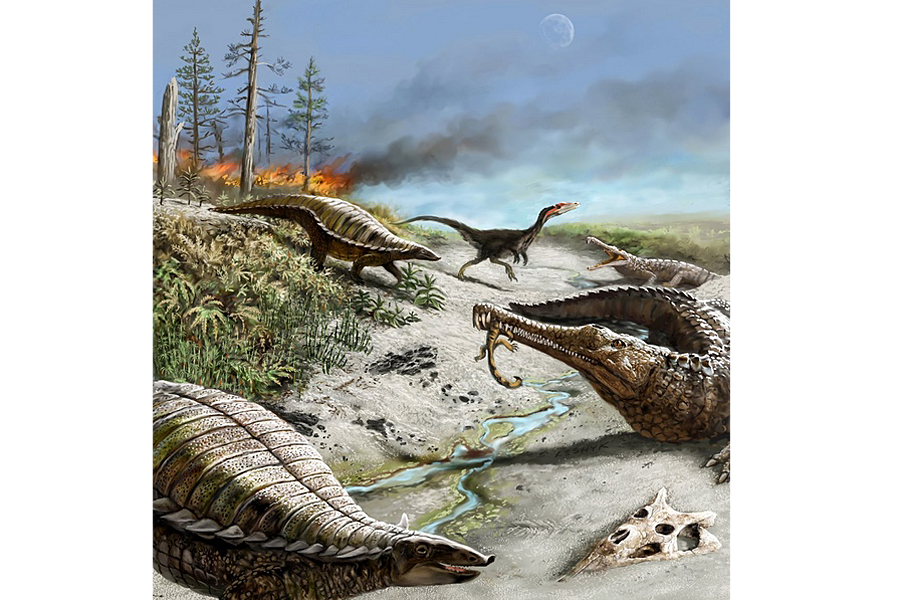Tropics were once so harsh that even giant dinos shied away, say scientists
Loading...
Giant dinosaurs steered clear of the tropics for tens of millions of years because wild climate swings there were too much for them to handle, researchers say.
This finding could shed light on troubles that climate change might bring in the next few centuries, scientists added.
Dinosaurs emerged about 230 million years ago in the late Triassic period. They came to dominate life on land for 135 million years during the subsequent Jurassic and Cretaceous periods, until a cosmic impact brought a cataclysmic end to the Age of Reptiles about 65 million years ago.
Within 15 million years after dinosaurs first appeared, multitudes of dinosaur species had evolved. Inexplicably, the giant long-necked, long-tailed, vegetarian dinosaurs known as sauropods — the largest creatures to ever walk the Earth — were rare in the low latitudes around the equator for up to 30 million years after their origin, even though they dominated high latitudes before then. [Images: One of the World's Biggest Dinosaurs Discovered]
"For several decades, researchers have noticed a curious case — large plant-eating dinosaurs seemed to be much more common at high latitudes during the Triassic," study lead author Jessica Whiteside, a geochemist at the University of Southampton in England, told Live Science. "However, it has only been in the past decade that we've realized they're completely missing from the tropics, where only a few small carnivorous dinosaurs dwelled."
Reconstructing dino-scapes
To help solve this mystery, Whiteside and her colleagues analyzed rocks from a location known as Ghost Ranch in New Mexico (which inspired famed artist Georgia O'Keeffe's landscape paintings). The researchers focused on the multicolored cliffs of the Chinle Formation, which are a common sight at places such as the Painted Desert at Petrified Forest National Park in Arizona.
For nine years, the investigators studied the rocks deposited by rivers and streams between 205 million and 215 million years ago, during the late Triassic, when the Americas and other land masses of the world were bound together in the supercontinent Pangea. Back then, the Ghost Ranch site resided near the equator at about the same latitude as the southernmost tip of India does today. The site is rich with fossils from the late Triassic.
The scientists reconstructed the first detailed look at the climate and ecology during the emergence of the dinosaurs by looking at a variety of types of data from the rocks. Fossil charcoal helped the scientists deduce wildfire temperatures; fossil bones, pollen and spores helped them figure out the kinds of animals and plants living in the region; isotopes of carbon and oxygen from fossil organic matter helped researchers estimate levels of atmospheric carbon dioxide and how much vegetation existed there at the time.
"Each dataset complements the others, and they all point towards similar conditions," Whiteside said in a statement. "I think this is one of the major strengths of our study."
Dinosaurs were rare among the fossils at Ghost Ranch, accounting for less than 15 percent of vertebrates, or animals with backbones. The dinosaurs were outnumbered in diversity, abundance and body size by the reptiles known as pseudosuchians, the lineage that gave rise to crocodiles and alligators. The few dinosaurs at the site were mostly small carnivores. [In Images: Ancient Monsters of the Sea]
Plant fossils helped fill in the picture. Different groups of plants at Ghost Ranch often alternated from common to rare, as suggested by shifting abundances of different types of pollen and spores. This hinted at repeated sudden changes in climate. In addition, the way that levels of carbon isotopes went up and down over time suggested that levels of vegetation could rise and fall depending on strong fluctuations in rainfall.
Fossil charcoal suggested that raging wildfires every few dozen years could reach temperatures of up to about 1,100 degrees Fahrenheit (600 degrees Celsius). These may have been due to abrupt shifts in climate that drove massive plant die-offs and fueled hotter fires.
Climate swings
The new findings suggest that the tropics in the late Triassic possessed a highly unpredictable hot climate that could swing between wet seasons in some years and extreme droughts in others. "The conditions would have been something similar to the arid Western United States today, although there would have been trees and smaller plants near streams and rivers and forests during humid times," Whiteside said in the statement.
This harsh, fluctuating climate and its repeated wildfires would have made it difficult for abundant vegetation to grow and survive, preventing giant herbivores from invading the region. "Only small two-legged carnivorous dinosaurs such as Coelophysis could survive," Whiteside said in the statement.
This highly unpredictable hot and dry climate was linked with high atmospheric levels of carbon dioxide that were "four to six times that of modern levels, but similar to levels predicted for 100 to 200 years in the future," Whiteside said. "These data therefore suggest there are potentially profound challenges to human sustainability in the future if we experience the high carbon dioxide conditions predicted to develop in the coming 100 to 200 years."
In the future, scientists could look at other tropical, late Triassic sites, Whiteside said.
She and her colleagues detailed their findings online June 15 in the journal Proceedings of the National Academy of Sciences.
Follow Live Science @livescience, Facebook & Google+. Originally published on Live Science.
- Images: Uncovering the Colossal Dreadnoughtus Dinosaur
- Gallery: Massive New Dinosaur Discovered in Sub-Saharan Africa
- Paleo-Art: Dinosaurs Come to Life in Stunning Illustrations
Copyright 2015 LiveScience, a Purch company. All rights reserved. This material may not be published, broadcast, rewritten or redistributed.







